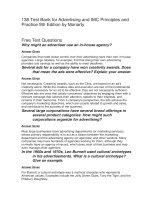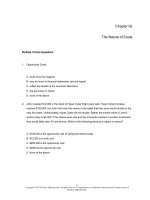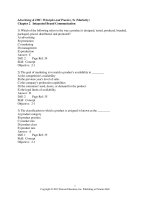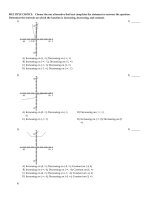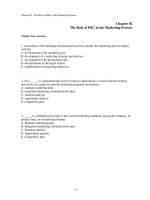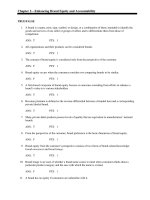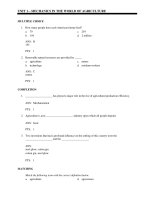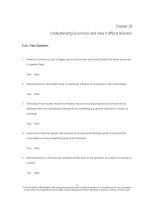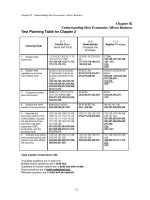Advertising and IMC principles and practice 9th edition moriarty test bank
Bạn đang xem bản rút gọn của tài liệu. Xem và tải ngay bản đầy đủ của tài liệu tại đây (215.79 KB, 38 trang )
Advertising & IMC: Principles and Practice, 9e (Moriarty)
Chapter 2 Integrated Brand Communication
1) Which of the following refers to the way a product is designed, tested, produced, branded,
packaged, priced, distributed, and promoted?
A) advertising
B) promotion
C) marketing
D) management
E) production
Answer: C
Diff: 2
Page Ref: 34
Skill: Concept
Objective: 2-1
2) The goal of marketing is to match a product's availability to ________.
A) the competition's availability
B) the previous year's level of sales
C) the company's production capabilities
D) the consumers' need, desire, or demand for the product
E) the legal limits of availability
Answer: D
Diff: 2
Page Ref: 35
Skill: Concept
Objective: 2-1
3) The classification to which a product is assigned is known as the ________.
A) product category
B) product position
C) market mix
D) product class
E) product mix
Answer: A
Diff: 1
Page Ref: 35
Skill: Concept
Objective: 2-1
1
Copyright © 2012 Pearson Education, Inc. Publishing as Prentice Hall
4) The four tools of product, price, place (distribution), and promotion are collectively referred to
as the ________.
A) product mix
B) promotion mix
C) marketing mix
D) integration elements
E) exchange elements
Answer: C
Diff: 1 Page Ref: 35
Skill: Concept
Objective: 2-1
5) The marketing mix is also known as the ________.
A) four Cs
B) four Ms
C) competitive advantage
D) marketing channel
E) four Ps
Answer: E
Diff: 1 Page Ref: 35
Skill: Concept
Objective: 2-1
6) The act of trading a desired product or service to receive something of value in return is called
a(n) ________.
A) distribution
B) position
C) exchange
D) market
E) demand
Answer: C
Diff: 1 Page Ref: 35
Skill: Concept
Objective: 2-1
7) Which of the following are considered "key players" in the marketing industry?
A) marketers
B) suppliers or vendors
C) distributors or retailers
D) agencies
E) all of the above
Answer: E
Diff: 2 Page Ref: 35
Skill: Concept
Objective: 2-1
2
Copyright © 2012 Pearson Education, Inc. Publishing as Prentice Hall
8) Which key player in marketing is the organization, company, or manufacturer producing the
product and offering it for sale?
A) marketer
B) supplier or vendor
C) distributor or retailer
D) agency
E) brand manager
Answer: A
Diff: 1 Page Ref: 35
Skill: Concept
Objective: 2-1
9) The materials and ingredients used in producing the product are obtained from other
companies that are referred to as a producer's ________.
A) marketers
B) suppliers or vendors
C) distributors or retailers
D) agencies
E) exchangers
Answer: B
Diff: 2 Page Ref: 36
Skill: Concept
Objective: 2-1
10) The complex network of suppliers that produce components and ingredients that are then
sold to the manufacturer is known as the ________.
A) network chain
B) channel of distribution
C) supply chain
D) ingredient chain
E) distribution chain
Answer: C
Diff: 1 Page Ref: 36
Skill: Concept
Objective: 2-1
11) The ________ refers to the various companies that are involved in moving a product from its
manufacturer into the hands of its buyer.
A) network chain
B) distribution chain
C) supply chain
D) ingredient chain
E) promotion network
Answer: B
Diff: 1 Page Ref: 36
Skill: Concept
Objective: 2-1
3
Copyright © 2012 Pearson Education, Inc. Publishing as Prentice Hall
12) What term is used to mean a place or a particular type of buyer?
A) market
B) position
C) channel
D) target
E) segment
Answer: A
Diff: 1 Page Ref: 37
Skill: Concept
Objective: 2-1
13) The percentage of the total sales in a product category that a particular brand has is called the
brand's ________.
A) position
B) market segment
C) distribution
D) share of market
E) exchange
Answer: D
Diff: 2 Page Ref: 37
Skill: Concept
Objective: 2-1
14) Which of the following is NOT considered a main type of market?
A) consumer
B) business-to-business
C) channel
D) institutional
E) media
Answer: E
Diff: 2 Page Ref: 37
Skill: Concept
Objective: 2-1
15) ________ markets consist of people who buy products and services for personal or
household use.
A) Consumer
B) Business-to-business
C) Channel
D) Institutional
E) Media
Answer: A
Diff: 1 Page Ref: 37
Skill: Concept
Objective: 2-1
4
Copyright © 2012 Pearson Education, Inc. Publishing as Prentice Hall
16) ________ markets consist of companies that buy products or services to use in their own
businesses or in making other products.
A) Consumer
B) Business-to-business
C) Distribution
D) Institutional
E) Indirect
Answer: B
Diff: 1 Page Ref: 37
Skill: Concept
Objective: 2-1
17) ________ markets include a wide variety of profit and nonprofit organizations, such as
hospitals, government agencies, and schools that provide goods and services for the benefit of
society.
A) Consumer
B) Business-to-business
C) Channel
D) Institutional
E) Distribution
Answer: D
Diff: 1 Page Ref: 37
Skill: Concept
Objective: 2-1
18) ________ markets are made up of members of a company's distribution chain.
A) Consumer
B) Business-to-business
C) Channel
D) Institutional
E) Media
Answer: C
Diff: 1 Page Ref: 37
Skill: Concept
Objective: 2-1
19) Resellers in a channel market are also known as ________.
A) suppliers
B) vendors
C) intermediaries
D) shareholders
E) competitors
Answer: C
Diff: 1 Page Ref: 37
Skill: Concept
Objective: 2-1
5
Copyright © 2012 Pearson Education, Inc. Publishing as Prentice Hall
20) Most advertising dollars are spent in ________ markets.
A) consumer
B) business-to-business
C) distribution
D) channel
E) institutional
Answer: A
Diff: 2 Page Ref: 37
Skill: Concept
Objective: 2-1
21) Firms usually reach ________ markets through mass media.
A) consumer
B) business-to-business
C) distribution
D) channel
E) institutional
Answer: A
Diff: 2 Page Ref: 37
Skill: Concept
Objective: 2-1
22) What is the first step in the marketing process?
A) Set objectives for the marketing effort.
B) Research the consumer market and the competitive marketplace and develop a situation
analysis.
C) Assess consumer needs and wants relative to the product, segment the market into groups that
are likely to respond, and target specific markets.
D) Differentiate and position the product relative to the competition.
E) Develop the marketing mix strategy.
Answer: B
Diff: 2 Page Ref: 39
Skill: Concept
Objective: 2-1
23) What is the second step in the marketing process?
A) Assess consumer needs and wants relative to the product, segment the market into groups that
are likely to respond, and target specific markets.
B) Set objectives for the marketing effort.
C) Research the consumer market and the competitive marketplace and develop a situation
analysis.
D) Differentiate and position the product relative to the competition.
E) Develop the marketing mix strategy.
Answer: B
Diff: 2 Page Ref: 39
Skill: Concept
Objective: 2-1
6
Copyright © 2012 Pearson Education, Inc. Publishing as Prentice Hall
24) Which of the steps in the marketing planning process listed below follows the others?
A) Assess consumer needs and wants relative to the product, segment the market into groups that
are likely to respond, and target specific markets.
B) Set objectives for the marketing effort.
C) Research the consumer market and the competitive marketplace and develop a situation
analysis.
D) Differentiate and position the product relative to the competition.
E) Develop the marketing mix strategy.
Answer: E
Diff: 3 Page Ref: 39
Skill: Concept
Objective: 2-1
25) Which of the following suggests that marketing should focus first on identifying the needs
and wants of the customer?
A) the exchange concept
B) the marketing concept
C) the product concept
D) the brand concept
E) the production concept
Answer: B
Diff: 1 Page Ref: 39
Skill: Concept
Objective: 2-1
26) How a brand is different and superior in some way is referred to as ________.
A) brand parity
B) brand equity
C) competitive advantage
D) psychological pricing
E) brand meaning
Answer: C
Diff: 1 Page Ref: 40
Skill: Concept
Objective: 2-1
27) Which of the following does NOT add value to a product?
A) advertising
B) convenience
C) useful features
D) branding
E) All of the above add value to a product.
Answer: E
Diff: 2 Page Ref: 41
Skill: Concept
Objective: 2-1
7
Copyright © 2012 Pearson Education, Inc. Publishing as Prentice Hall
28) Which of the following is NOT a way advertising adds value to a product?
A) making the product appear more desirable
B) making the product appear more of a status symbol
C) making the product more convenient for consumers to buy
D) providing news and useful information of interest to consumers
E) All of the above are ways advertising adds value to a product.
Answer: C
Diff: 3 Page Ref: 41
Skill: Concept
Objective: 2-1
29) Which marketing element includes product design and development, performance, branding,
and packaging?
A) distribution
B) branding
C) product
D) place
E) promotion
Answer: C
Diff: 1 Page Ref: 41
Skill: Concept
Objective: 2-1
30) Which marketing element includes personal selling, advertising, public relations, sales
promotion, direct marketing, events and sponsorships, point-of-purchase, and the communication
aspects of packaging?
A) price
B) distribution
C) product
D) place
E) promotion
Answer: E
Diff: 1 Page Ref: 41
Skill: Concept
Objective: 2-1
31) The promotion "P" of marketing is also known as ________.
A) product
B) distribution
C) price
D) marketing communication
E) differentiation
Answer: D
Diff: 1 Page Ref: 41
Skill: Concept
AACSB: Communication abilities
Objective: 2-1
8
Copyright © 2012 Pearson Education, Inc. Publishing as Prentice Hall
32) Which element of the marketing mix includes distribution channels, market coverage, and
co-op advertising?
A) product
B) promotion
C) price
D) communication
E) place
Answer: E
Diff: 1 Page Ref: 41
Skill: Concept
Objective: 2-2
33) Which of the following is LEAST likely to be a factor on which the price of a product is
based?
A) what the market will bear
B) the amount of support provided by resellers
C) economic well-being of the consumer
D) the consumer's ability to gauge the value
E) the relative value of the product
Answer: B
Diff: 3 Page Ref: 42
Skill: Concept
Objective: 2-1
34) A consumer's ability to gauge the value of a product is referred to as the ________.
A) psychological price
B) price/value proposition
C) exchange rate
D) comparative price
E) value exchange
Answer: B
Diff: 2 Page Ref: 42
Skill: Concept
Objective: 2-1
35) Which pricing strategy uses marketing communication to manipulate the customer's
judgment of value?
A) psychological pricing
B) value pricing
C) distribution pricing
D) copy pricing
E) customary pricing
Answer: A
Diff: 1 Page Ref: 42
Skill: Concept
Objective: 2-1
9
Copyright © 2012 Pearson Education, Inc. Publishing as Prentice Hall
36) Which pricing strategy is used to communicate a dramatic or temporary price reduction?
A) promotional pricing
B) value pricing
C) parity pricing
D) copy pricing
E) customary pricing
Answer: A
Diff: 2 Page Ref: 42
Skill: Concept
Objective: 2-1
37) Using ________, a marketer sets a high price for a product to make the product seem worthy
or valuable.
A) prestige pricing
B) value pricing
C) distribution pricing
D) promotional pricing
E) customary pricing
Answer: A
Diff: 2 Page Ref: 42
Skill: Concept
Objective: 2-1
38) When a company distributes its products directly to buyers without the use of a reseller, the
company is using ________.
A) indirect marketing
B) no-channel marketing
C) direct marketing
D) indirect channel marketing
E) integrated marketing
Answer: C
Diff: 1 Page Ref: 42
Skill: Concept
Objective: 2-1
39) When a company distributes its products through one or more distributors and resellers, the
company is using ________.
A) channel marketing
B) no-channel marketing
C) direct marketing
D) multi-level marketing
E) integrated marketing
Answer: A
Diff: 2 Page Ref: 43
Skill: Concept
Objective: 2-1
10
Copyright © 2012 Pearson Education, Inc. Publishing as Prentice Hall
40) Which strategy directs marketing efforts at the consumer?
A) push
B) exchange
C) pull
D) coverage
E) cooperative
Answer: C
Diff: 1 Page Ref: 43
Skill: Concept
Objective: 2-1
41) A ________ strategy directs marketing efforts at resellers, and success depends on the ability
of these intermediaries to market the product, which they often do with advertising.
A) push
B) pull
C) coverage
D) direct
E) exchange
Answer: A
Diff: 1 Page Ref: 43
Skill: Concept
Objective: 2-1
42) Which marketing communication tool uses face-to-face contact between the marketer and a
prospective customer?
A) advertising
B) sales promotion
C) public relations
D) personal sales
E) customary marketing
Answer: D
Diff: 1 Page Ref: 43
Skill: Concept
AACSB: Communication abilities
Objective: 2-1
43) Which of the following refers specifically to creating the tangible and intangible elements of
a brand?
A) advertising
B) branding
C) exchanging
D) marketing
E) integrating
Answer: B
Diff: 1 Page Ref: 44
Skill: Concept
Objective: 2-2
11
Copyright © 2012 Pearson Education, Inc. Publishing as Prentice Hall
44) Computers, automobiles, and toothpaste are all examples of ________.
A) services
B) ideas
C) brands
D) products
E) markets
Answer: D
Diff: 2 Page Ref: 44
Skill: Concept
Objective: 2-2
45) A(n) ________ is a perception, often imbued with emotion, which results from experiences
with and information about a company or a line of products.
A) advertisement
B) brand
C) tagline
D) logo
E) trademark
Answer: B
Diff: 1 Page Ref: 44
Skill: Concept
Objective: 2-2
46) Which of the following is the harmonization of an organization's identity and its image?
A) integrated marketing communication
B) standardized marketing
C) channel marketing
D) organizational branding
E) brand transformation
Answer: D
Diff: 2 Page Ref: 45
Skill: Concept
Objective: 2-2
47) Parity products are those that have ________.
A) no brand name
B) few competitors
C) few distinguishing features
D) a store's label
E) an international market
Answer: C
Diff: 1 Page Ref: 46
Skill: Concept
Objective: 2-2
12
Copyright © 2012 Pearson Education, Inc. Publishing as Prentice Hall
48) Store brands are also referred to as ________.
A) generic brands
B) private labels
C) regional brands
D) fast-moving consumer goods
E) licensed brands
Answer: B
Diff: 2 Page Ref: 46
Skill: Concept
Objective: 2-2
49) Which of the following were originally sold in black-and-white, no-frills packaging at low
prices?
A) generic brands
B) private labels
C) regional brands
D) fast-moving consumer goods
E) licensed brands
Answer: A
Diff: 1 Page Ref: 46
Skill: Concept
Objective: 2-2
50) Which of the following was the top global brand, based on brand value, in 2009?
A) Google
B) Microsoft
C) Coca-Cola
D) McDonald's
E) Walmart
Answer: A
Diff: 2 Page Ref: 48
Skill: Concept
AACSB: Dynamics of the global economy
Objective: 2-2
51) Which of the following is NOT a desirable quality for a brand name?
A) It should suggest something about the product's benefits and qualities.
B) It should be easy to pronounce, recognize, and remember.
C) The brand should be a long word to get attention.
D) The name should translate easily into foreign languages.
E) It should be distinctive.
Answer: C
Diff: 3 Page Ref: 49
Skill: Concept
Objective: 2-2
13
Copyright © 2012 Pearson Education, Inc. Publishing as Prentice Hall
52) A ________ is a legal sign that indicates ownership.
A) trademark
B) logo
C) brand
D) brand license
E) brand position
Answer: A
Diff: 1 Page Ref: 49
Skill: Concept
Objective: 2-2
53) ________ refers to how consumers see a brand relative to the other brands in the product
category.
A) Segmenting
B) Targeting
C) Differentiating
D) Positioning
E) Trademarking
Answer: D
Diff: 2 Page Ref: 50
Skill: Concept
Objective: 2-2
54) Bold, fun, exciting, and daring are all examples of ________.
A) brand promises
B) brand positions
C) brand personalities
D) brand images
E) brand value
Answer: C
Diff: 2 Page Ref: 50
Skill: Concept
Objective: 2-2
55) Brand value comes in two forms: the value to the ________ and the value to the ________.
A) consumer; competitor
B) consumer; corporation
C) competitor; channel
D) corporation; competitor
E) shareholder; stakeholder
Answer: B
Diff: 2 Page Ref: 51
Skill: Concept
Objective: 2-2
14
Copyright © 2012 Pearson Education, Inc. Publishing as Prentice Hall
56) Brand ________ programs offer customers rewards for repeat business.
A) value
B) equity
C) extension
D) integration
E) loyalty
Answer: E
Diff: 1 Page Ref: 51
Skill: Concept
Objective: 2-2
57) ________ is the intangible value of the brand based on the relationships with its
stakeholders, as well as intellectual property.
A) Brand position
B) Brand parity
C) Brand image
D) Brand identity
E) Brand equity
Answer: E
Diff: 1 Page Ref: 51-52
Skill: Concept
Objective: 2-2
58) Which of the following measures the financial value the brand contributes to a company?
A) trademark
B) copyright
C) brand image
D) brand identity
E) brand equity
Answer: E
Diff: 2 Page Ref: 51
Skill: Concept
Objective: 2-2
59) ________ refers to promoting and advertising the use of a brand name for a component used
in manufacturing a product.
A) Co-branding
B) Ingredient branding
C) Inside branding
D) Brand licensing
E) Integrated branding
Answer: B
Diff: 1 Page Ref: 52
Skill: Concept
Objective: 2-2
15
Copyright © 2012 Pearson Education, Inc. Publishing as Prentice Hall
60) A company that uses an established brand name with a related line of products is using a(n)
________.
A) co-brand
B) ingredient brand
C) brand extension
D) licensed brand
E) brand parity
Answer: C
Diff: 1 Page Ref: 52
Skill: Concept
Objective: 2-2
61) Which of the following is a strategy that uses two brand names owned by two separate
companies to create a partnership offering?
A) co-branding
B) equity branding
C) brand licensing
D) integrated branding
E) parity branding
Answer: A
Diff: 1 Page Ref: 52
Skill: Concept
Objective: 2-2
62) Using ________, a partner company rents another company's brand name and transfers some
of that brand equity to another product.
A) co-branding
B) equity branding
C) brand licensing
D) integrated branding
E) parity branding
Answer: C
Diff: 1 Page Ref: 52
Skill: Concept
Objective: 2-2
16
Copyright © 2012 Pearson Education, Inc. Publishing as Prentice Hall
63) Advertising, sales promotion, personal selling, public relations, and direct marketing are all
________.
A) promotional tools that should be integrated under the concept of integrated marketing
communications
B) promotional tools used in business-to-business markets but not consumer markets
C) promotional tools used for push strategies but not pull strategies
D) promotional tools used for pull strategies but not push strategies
E) promotional tools used in consumer markets but not business-to-business markets
Answer: A
Diff: 2 Page Ref: 53
Skill: Concept
Objective: 2-3
64) More companies are adopting the concept of ________, which is the practice of unifying all
marketing communication messages and tools as well as the messages from the marketing mix
decisions so that they send a consistent message supporting the brand's strategy.
A) integrated marketing communications
B) integrated personal selling
C) integrated competitive methods
D) nonpersonal communication channels
E) buzz marketing
Answer: A
Diff: 1 Page Ref: 53
Skill: Concept
AACSB: Communication abilities
Objective: 2-3
65) Integrated marketing communications produces better communications ________.
A) consistency
B) sales
C) simplicity
D) variety
E) independence
Answer: A
Diff: 2 Page Ref: 53
Skill: Concept
AACSB: Communication abilities
Objective: 2-3
17
Copyright © 2012 Pearson Education, Inc. Publishing as Prentice Hall
66) Integrated marketing communications require a company's mass-market advertisements,
Web site, e-mail, and personal selling communications to all have ________.
A) equal portions of the advertising budget
B) the same return on investment
C) separate marketing objectives
D) the same target audience
E) the same message, look, and feel
Answer: E
Diff: 2 Page Ref: 53
Skill: Concept
Objective: 2-3
67) Which of the following is NOT a principle of IMC?
A) Everything communicates.
B) A brand is a unified vision and a complex system.
C) Brand relationships drive brand value.
D) You can't be integrated externally if you are not integrated internally.
E) Every element of the marketing mix should provide equal return on investment.
Answer: E
Diff: 3 Page Ref: 54
Skill: Concept
Objective: 2-3
68) A ________ brand is one marketed in a single country.
A) house
B) local
C) regional
D) store
E) private
Answer: B
Diff: 1 Page Ref: 56
Skill: Concept
AACSB: Dynamics of the global economy
Objective: 2-4
69) A(n) ________ brand is available in a number of different countries in various parts of the
world.
A) parity
B) local
C) regional
D) extension
E) international
Answer: E
Diff: 1 Page Ref: 56
Skill: Concept
AACSB: Dynamics of the global economy
Objective: 2-4
18
Copyright © 2012 Pearson Education, Inc. Publishing as Prentice Hall
70) A company that takes a ________ approach to international marketing tries to make
accommodations in its marketing mix for cultural differences.
A) parity
B) domestic
C) global
D) standardized
E) localized
Answer: E
Diff: 2 Page Ref: 57
Skill: Concept
AACSB: Dynamics of the global economy
Objective: 2-4
71) Marketing is the way a product is designed, tested, produced, branded, packaged, priced,
distributed, and promoted.
Answer: TRUE
Diff: 1 Page Ref: 34
Skill: Concept
Objective: 2-1
72) The goal in marketing is to sell as many products as possible.
Answer: FALSE
Diff: 2 Page Ref: 34
Skill: Concept
Objective: 2-1
73) The key players in the marketing industry include the marketer, suppliers or vendors,
distributors and retailers, and agencies.
Answer: TRUE
Diff: 2 Page Ref: 35
Skill: Concept
Objective: 2-1
74) The materials and ingredients used in producing the product are obtained from other
companies who are referred to as distributors.
Answer: FALSE
Diff: 2 Page Ref: 36
Skill: Concept
Objective: 2-1
75) The channel of distribution refers to the complex network of suppliers who produce
components and ingredients that are then sold to the manufacturer.
Answer: FALSE
Diff: 2 Page Ref: 36
Skill: Concept
Objective: 2-1
19
Copyright © 2012 Pearson Education, Inc. Publishing as Prentice Hall
76) The supply chain refers to the various companies that are involved in moving a product from
its manufacturer into the hands of its buyer.
Answer: FALSE
Diff: 2 Page Ref: 37
Skill: Concept
Objective: 2-1
77) Only manufacturers advertise.
Answer: FALSE
Diff: 2 Page Ref: 37
Skill: Concept
Objective: 2-1
78) When marketing strategists speak of markets, they generally refer to a particular type of
buyer.
Answer: TRUE
Diff: 2 Page Ref: 37
Skill: Concept
Objective: 2-1
79) Institutional markets consist of people who buy products and services for personal use.
Answer: FALSE
Diff: 1 Page Ref: 37
Skill: Concept
Objective: 2-1
80) Institutional markets are made up of nonprofit organizations only.
Answer: FALSE
Diff: 2 Page Ref: 37
Skill: Concept
Objective: 2-1
81) Most goods manufacturers also offer services.
Answer: TRUE
Diff: 3 Page Ref: 38
Skill: Concept
Objective: 2-1
82) The first step in the marketing planning process is to set objectives for the marketing effort.
Answer: FALSE
Diff: 2 Page Ref: 39
Skill: Concept
Objective: 2-1
20
Copyright © 2012 Pearson Education, Inc. Publishing as Prentice Hall
83) In the marketing planning process, consumer needs should be assessed before the product is
positioned.
Answer: TRUE
Diff: 3 Page Ref: 39
Skill: Concept
Objective: 2-1
84) A company that operates with a marketing concept philosophy focuses on satisfying its
customers' needs and wants.
Answer: TRUE
Diff: 1 Page Ref: 39
Skill: Concept
Objective: 2-1
85) The process of assessing whether there are identifiable groups within the market whose
needs and wants intersect with the product and its features is known as differentiation.
Answer: FALSE
Diff: 2 Page Ref: 40
Skill: Concept
Objective: 2-1
86) The process of making a brand stand out as different from its competition is called
positioning.
Answer: TRUE
Diff: 1 Page Ref: 40
Skill: Concept
Objective: 2-1
87) Customer is a more general term than consumer.
Answer: FALSE
Diff: 3 Page Ref: 40
Skill: Concept
Objective: 2-1
88) Advertising can add value to a brand.
Answer: TRUE
Diff: 2 Page Ref: 41
Skill: Concept
Objective: 2-1
89) A push strategy directs marketing efforts at the consumer in an attempt to stimulate
consumer demand.
Answer: FALSE
Diff: 2 Page Ref: 43
Skill: Concept
Objective: 2-1
21
Copyright © 2012 Pearson Education, Inc. Publishing as Prentice Hall
90) In personal sales, leads are also known as prospects.
Answer: TRUE
Diff: 2 Page Ref: 43
Skill: Concept
Objective: 2-1
91) Advertising is the process of creating the tangible and intangible elements of a brand.
Answer: FALSE
Diff: 2 Page Ref: 44
Skill: Concept
Objective: 2-2
92) Brand equity measures the financial value the brand contributes to the company.
Answer: TRUE
Diff: 2 Page Ref: 51
Skill: Concept
Objective: 2-2
93) Co-branding means acknowledging a supplier's brand as an important product feature or
component.
Answer: FALSE
Diff: 2 Page Ref: 52
Skill: Concept
Objective: 2-2
94) Integrated marketing communication (IMC) is a recent trend that uses databases to drive
communication with customers and keep track of their interactions with a company.
Answer: FALSE
Diff: 1 Page Ref: 53
Skill: Concept
AACSB: Use of information technology
Objective: 2-3
95) An IMC program is more complex than a traditional advertising plan.
Answer: TRUE
Diff: 3 Page Ref: 53
Skill: Concept
Objective: 2-3
96) Implementation of IMC is most successful through the use of cross-functional organization.
Answer: TRUE
Diff: 2 Page Ref: 54
Skill: Concept
AACSB: Communication abilities
Objective: 2-3
22
Copyright © 2012 Pearson Education, Inc. Publishing as Prentice Hall
97) In marketing terms, ROI stands for rate of interest.
Answer: FALSE
Diff: 1 Page Ref: 55
Skill: Concept
Objective: 2-4
98) Marketers who calculate ROI do not need to use other tools or techniques to evaluate the
efficiency and effectiveness of their marketing communications.
Answer: FALSE
Diff: 2 Page Ref: 55
Skill: Concept
Objective: 2-4
99) The calculation of ROI identifies how much money a brand made in comparison to its
expenses.
Answer: TRUE
Diff: 2 Page Ref: 55
Skill: Concept
Objective: 2-4
100) The growth in global marketing activities continues to increase.
Answer: TRUE
Diff: 2 Page Ref: 56
Skill: Concept
AACSB: Dynamics of the global economy
Objective: 2-4
101) A car manufacturer buys tires from a tire manufacturer. These manufacturers are part of the
institutional market.
Answer: FALSE
Diff: 2 Page Ref: 37
Skill: Application
AACSB: Analytic skills
Objective: 2-1
102) Businesses are more likely to use advertising in specialized media than in mass media to
reach customers in business-to-business markets.
Answer: TRUE
Diff: 2 Page Ref: 37
Skill: Critical Thinking
AACSB: Reflective thinking skills
Objective: 2-1
23
Copyright © 2012 Pearson Education, Inc. Publishing as Prentice Hall
103) Diane is a repeat buyer of Dove beauty products. Diane is a consumer who is Dove's
customer.
Answer: TRUE
Diff: 2 Page Ref: 40
Skill: Application
AACSB: Analytic skills
Objective: 2-1
104) Retailers and wholesalers who have created their own brands–such as Walmart's Sam's
Choice beverages and food products–are participating in co-branding.
Answer: FALSE
Diff: 3 Page Ref: 46
Skill: Application
AACSB: Reflective thinking skills
Objective: 2-2
105) To maximize the toothpaste market in China, Crest needs to convince more of the Chinese
population to brush their teeth three times a day. Crest is most likely to use a standardized
approach for its marketing in China.
Answer: FALSE
Diff: 2 Page Ref: 57
Skill: Application
AACSB: Analytic skills
Objective: 2-4
106) Describe the roles of the four categories of key players in marketing.
Answer:
(1) Marketer (a.k.a Advertiser or Client) Any company or organization behind the product (i.e.,
the organization, company, or manufacturer producing the product and offering it for sale).
(2) Suppliers and Vendors Supply the materials and ingredients used in producing the product.
In marketing practice these suppliers and vendors are partners in the creation of a successful
product. The term supply chain refers to the network of suppliers who produce components that
are sold to manufacturers.
(3) Distributors and Retailers Companies that are involved in moving a product from its
manufacturer into the hands of its buyer. The various companies involved in this are referred to
as the channel of distribution.
(4) Marketing partners Do all or part of the work of advertising, implementing the creative
vision of the client (marketer), and helping it to reach its advertising goals.
Diff: 2 Page Ref: 35-37
Skill: Synthesis
AACSB: Reflective thinking skills
Objective: 2-1
24
Copyright © 2012 Pearson Education, Inc. Publishing as Prentice Hall
107) Name and describe the four main types of markets, and discuss characteristics of
advertising targeted toward each market, respectively.
Answer:
(1) Consumer Markets Consist of people who buy products and services for personal or
household use. Just about any product an individual purchases including clothing, food, books,
health and beauty aids, and so forth can be advertised to consumers through mass media such as
radio, television, newspapers, general consumer magazines, and direct-response media, such as
direct mail. Businesses spend most of their advertising dollars on this market.
(2) Business-to-Business (B2B) Markets Consist of companies that buy products or services to
use in their own businesses or in making other products. This market is typically reached through
trade and professional advertising in specialized media, such as trade journals, professional
magazines, and direct mail.
(3) Institutional Markets Include a wide variety of profit and nonprofit organizations, such as
hospitals, government agencies, and schools, which provide goods and services for the benefit of
society. This market is typically reached through the same means as industrial markets.
(4) Channel Markets Made up of members of the distribution chain, also known as resellers or
intermediaries. This market is also typically reached through the same means as industrial and
institutional markets.
Diff: 3 Page Ref: 37
Skill: Synthesis
AACSB: Reflective thinking skills
Objective: 2-1
108) Explain the marketing concept and discuss how it relates to advertising.
Answer: The marketing concept says that marketing should focus first on identifying the needs
and wants of the customer, rather than on finding ways to sell products that may or may not meet
customers' needs. This concept suggests that marketers must first determine the customers' needs
and wants and then develop, manufacture, market, and service goods that fill those particular
needs and wants, thus creating solutions for customers' problems. Both of these steps are
addressed in advertising planning through consumer research and the methods used by planners
to develop insight into consumer decision making. Advertising that follows the marketing
concept will focus more on the consumer's benefit than on a product's features.
Diff: 2 Page Ref: 39-40
Skill: Synthesis
AACSB: Reflective thinking skills
Objective: 2-1
25
Copyright © 2012 Pearson Education, Inc. Publishing as Prentice Hall
